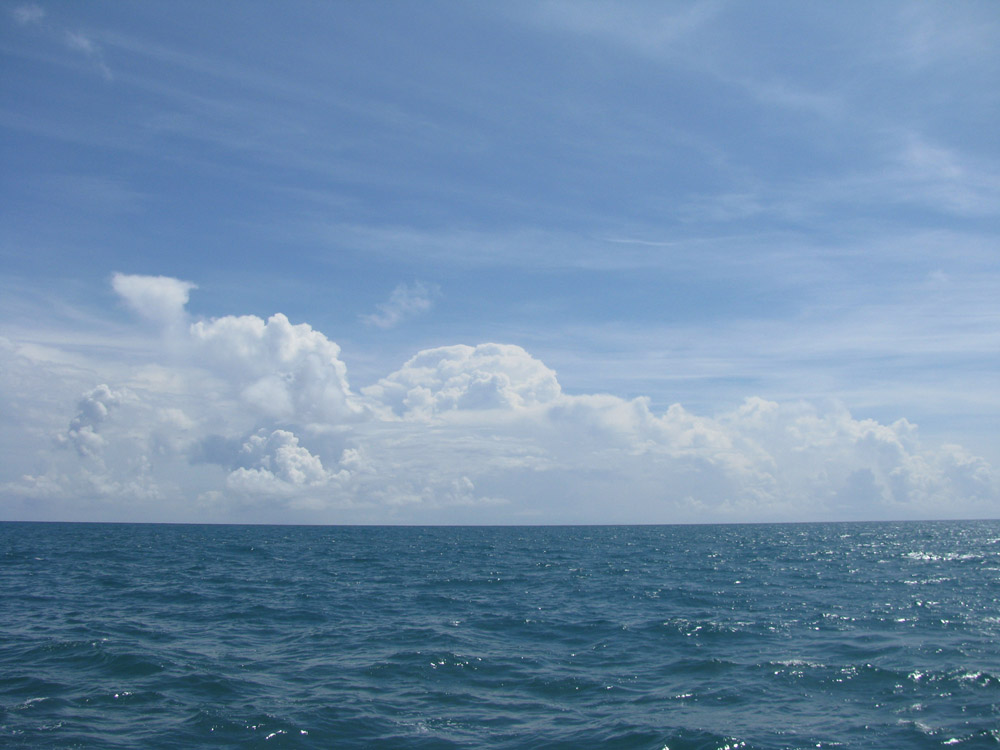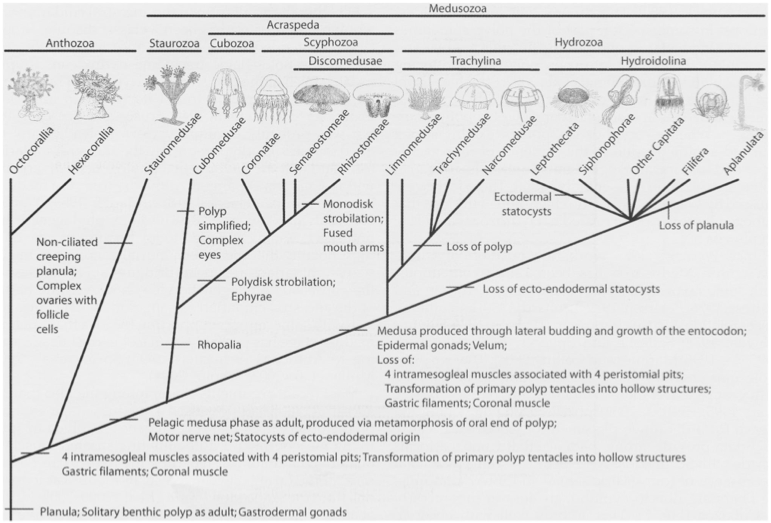Classification
Domain-Eukarya: The cells of Aequorea victoria contain a nucleus, so it is classified in the domain Eukarya. Other additional eukaryotic traits are present in Aequorea victoria as well such as compartmentalization of cells and DNA storage in the cell nucleus. (click here for an example of a unicellular eukaryote)
Kingdom-Animalia: Aequorea victoria is multicellular, and it lacks a cell wall. These traits categorize Aequorea victoria a member of the Animalia kingdom. Additionally, Aequorea victoria gathers nutrients through ingestion and digestion of other organisms, which is another trait of the Animalia.
Phylum- Cnidaria: Animals that lack mesodermal tissues are known as cnidarians, this includes Aequorea victoria. Additionally, cnidarians are radially symmetric and have only one orifice that is responsible for both ingestion of food and excretion of waste. (click here for a cnidarian organism)
Class- Hydrozoa: Aequorea victoria is a member of the hydrozoans, which are distinguished by their reproductive cycles. The medusae stage of Aequorea victoria is formed from the reproductive process known as budding, and its gametes are formed from ectodermal tissue. These traits are unique to hydrozoans (University of Michigan, 2013). (click here for another hydrozoan)
Order-Leptomedusae/Leptothecata: Aequorea victoria is a member of the order Leptomedusae, which are characterized by their colonial polyps and single whorl tentacles (University of Michigan, 2013).
Family-Aequoreidae: As a member of the Aequoreidae family Aequorea victoria exhibits characteristics such as a large circular manubrium containing multiple simple or branched radial canals. Also, gonads are present on radial canals but are separated from the manubrium (Marine Species, 2013).
Genus-Aequorea: Aequorea victoria of the Aequorea genus has many simple radial canals and a subumbrella lacking rows of gelatinous papillae (Marine Species, 2013).
Species-Aequorea victoria: The species Aequorea victoria is the largest of the Hydrozoans. This species is found in the Pacific Northwest (click here for link to habitat) (Encyclopedia of Life, 2013).
Figure 1. Modified from Phylogenetics of Hydroidolina (Hydrozoa: Cnidaria), Proposed hypothesis for the relationship of hydrozoans based on sequence differentiation of nearly complete 28s, nearly complete 18s, and partial complete 16s rDNA arrays (Cartwright et al., 2008).
Aequorea victoria is closely
related to other hydrozoans at the molecular level (fig. 1).
The hypothesis Dr. Cartwright's team formed supports the
classification of Aequorea victoria in the order Leptothecata
because of the large amount of similar DNA Aequorea victoria shares with
other species of the order Leptothecata (fig. 1).
Looking at how closely related the various Aequorea species
actually are based on molecular data could be very helpful in the
further classification of the genus Aequorea into species like
Aequorea
victoria. Additionally, more clearly defining the molecular
parameters of hydrozoans like Aequorea could be helpful in determining the
habitat ranges (click here for habitat of
Aquorea victoria) of species that are currently not well defined.
Molecular data also has research implications. Using this
molecular data could lead to isolation of DNA and
protein sequences with useful research and medical applications
(fig. 1).
For example, GFP was discovered and isolated in Aequorea victoria
(Shimomura, 1995), and it has since been replicated and used in
biological research (Cubitt et al., 1998). (click
here for link to GFP organisms)
Figure 2. Modified from Medusozoan Phylogeny and Character Evolution Clarified by New Large and Small Subunit rDNA Data and an Assessment of the Utility of Phylogenetic Mixture Models. Hypothesis for ancestral relationships between cnidarians at the order level based on morphological differences with the tips of the phylogeny displaying unique character traits (Collins et al., 2006).
Aequorea victoria is a member of the order Leptothecata,
which is compared morphologically with other cnidarian orders (fig.
2).
Having a field guide to the phylogenetic history of a group of
organisms could be a useful tool for comparative analysis
between two different lineages at the order level. In this
sense, fig. 2 could be used as dichotomous key. Given a
cnidarian organism and this tree a field researcher could place the
organism in the proper order based on its morphological traits.
Studying order level relationships could also be useful
for macro studies of organisms only tangentially related by traits
found at the order level. For example, the trait planula relates
the phylums Octocorallia and Leptothecata (fig. 2). This
characteristic links two seemingly very different organisms with the
homologous trait planula. Once a
relationship like this is established, linking other homologous
traits could be useful in synthesizing the evolutionary history of
related organisms, from which new phylogenies can be created.
These relationships could then be useful in determining when
phylogenetic nodes occurred that gave rise to new species with
apomorphic traits.
Also, another important factor in understanding macro level relationships between organisms is habitat. Click the habitat button below for more information about the habitat of Aequorea victoria.


